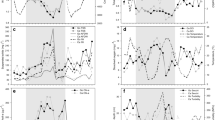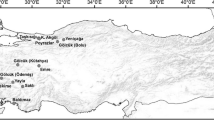Abstract
Macrozoobenthos in Thingvallavatn is dominated by 42 taxa. The vertical distribution delimits 5 communities: (1) the surf zone community from 0–2 m, (2) the upper stony littoral community from 2–6 m, (3) the lower stony littoral community from 6–10 m, (4) the Nitella zone community from 10–20 m, and (5) the profundal zone community from 20–114 m. Total mean lakewide production was 78 kJ m−2 yr−1. Herbivores, detritivores, and carnivores contributed 59%, 38% and 3%, respectively. Respiration and ingestion were estimated according to the literature. Net production efficiency averaged 0.50. Ingestion was dominated by herbivores in the littoral zones (46–81%), while detritivores made up 93% in the profundal zone. Total zoobenthic production averaged 6% of estimated available food with a range from 10–11% in the three upper littoral zones to only 2% in the Nitella zone. The profundal fauna converted 6% of the estimated sedimentation of organic matter to secondary production. On a lakewide basis the zoobenthis utilized one third of the estimated potential food resources. Zoobenthic production made up 32% of total secondary production.
Similar content being viewed by others
References
Antonsson, U., 1992. The structure and function of the zooplankton community in Thingvallavatn. Oikos 64: 188–221.
Armitage, P. D., 1968. Some notes on the food of the chironomid larvae of a shallow woodland lake in South Finland. Ann. Zool. Fennici 5: 6–13.
Benke, A. C., 1984. Secondary production of aquatic insect. In V. H. Resh D. M. Rosenberg (eds) The ecology of aquatic insects. Praeger, New York: 289–322.
Berrie, A. D., 1976. Detritus, micro-organisms and animals in fresh water. In J. M. Anderson & A. MacFadyen (eds), The role of terrestrial and aquatic organisms in decomposition processes. Blackwell Scientific, Oxford: 323–338.
Bowker, D. W., M. T. Wareham & M. A. Learner, 1983. The selection and ingestion of epilithic algae by s Nais elinguis (Oligochaeta: Naididae). Hydrobiologia 98: 171–178.
Brinkhurst, R. O., K. E. Chua & N. K. Kaushik, 1972. Interspecific interactions and selective feeding by tubificid oligochaetes. Limnol. Oceanogr. 17: 122–133.
Bullock, T. H., 1955. Compensation for temperature in the metabolism and activity of poikilotherms. Biol. Rev. 30: 311–342.
Calow, P., 1970. Studies on the natural diet of Lymnaea pereger obtusa (Kobelt) and its possible ecological implications. Proc. Malacol. Soc. Lond. 39: 203–215.
Hamburger, K. & P. C. Dall, 1990. The respiration of common benthic invertebrate species from the shallow littoral zone of Lake Esrom, Denmark. Hydrobiologia 199: 117–130.
Heal, O. W. & S. F. MacLean Jnr., 1975. Comparative productivity in ecosystems-secondary productivity. In W. H. van Dobben & R. H. Lowe-McConnell (eds), Unifying concepts in ecology. Dr W. Junk, The Hague: 89–108.
Holopainen, I. J. & L. Paasivirta, 1977. Abundance and biomass of the meiozoobenthos in the oligotrophic and mesohumic lake Pääjärvi, southern Finland. Ann. Zool. Fennici 14: 124–134.
Holopainen, I. J. & I. Hanski, 1979. Annual energy flow in populations of two Pisidium species (Bivalvia, Sphaeriidae), with discussion on possible competition between them. Arch. Hydrobiol. 86: 338–354.
Humphreys, W. F., 1979. Production and respiration in animal populations. J. anim. Ecol. 48: 427–453.
Ivlev, V., 1939. Transformation of energy by aquatic animals. Coefficient of energy consumption by Tubifex tubifex (Oligochaeta). Int. Revue ges. Hydrobiol. 38: 449–459.
Ivleva, I. V., 1980. The dependence of crustacean respiration rate on body mass and habitat temperature. Int. Revue ges. Hydrobiol. 65: 1–47.
Jensen, P., 1982. Diatom-feeding behaviour of the free-living marine nematode Chromadorita tenuis. Nematologica 28: 71–76.
Jónasson, P. M., 1978. Zoobenthos of lakes. Verh. int. Ver. Limnol. 20: 13–37.
Jónasson, P. M., 1984. The ecosystem of eutrophic Lake Esrom. In F. B. Taub (ed.), Lakes and Reservoirs. Ecosystems of the World 23: 177–204.
Jónasson, P. M., 1992. The ecosystem of Thingvallavatn. Oikos 64: 405–434.
Jónasson, P. M., C. Lindegaard, P. C. Dall, K. Hamburger & H. Adalsteinsson, 1990a. Ecosystem studies on temperate Lake Esrom and the subarctic lakes Myvatn and Thingvallavatn. Limnologica 20: 259–266.
Jónasson, P. M., T. Lindem, S. Snorrason, H. J. Malmquist, O. T. Sandlund, B. Jonsson, K. P. Magnusson, S. Skúlason & R. Gydemo, 1990b. Feeding pattern of planktivorous Arctic charr. Int. mountain watershed symp. Subalpine processes and water quality. California Univ. Press, 15 pp.
Jónasson, P. M., H. Adalsteinsson & G. Jónsson, 1992. Production and nutrient supply of phytoplankton in subarctic, dimictic Thingvallavatn. Oikos 64: 162–187.
Johnson, M. G. & R. O. Brinkhurst, 1971. Benthic community metabolism in Bay of Quinte and Lake Ontario. J. Fish Res. Bd Can. 28: 1715–1725.
Jónsson, G. S., 1987. The depth-distribution and biomass of epilithic periphyton in Lake Thingvallavatn, Iceland. Arch. Hydrobiol. 108: 531–547.
Jónsson, G. S., 1992. Photosynthesis and production of epilithic algal communities in Thingvallavatn. Oikos 64: 222–240.
Kairesalo, T. & I. Koskimies, 1987. Grazing by oligochaetes and snails on epiphytes. Freshwat. Biol. 17: 317–324.
Kairesalo, T., G. S. Jónsson, K. Gunnarsson & P. M. Jónasson, 1989. Macro- and microalgal production within a Nitella opaca bed in Lake Thingvallavatn, Iceland. J. Ecol. 77: 332–342.
Kairesalo, T., G. S. Jónsson, K. Gunnarsson, C. Lindegaard & P. M. Jónasson, 1992. Metabolism and community dynamics within Nitella opaca beds in Thingvallavatn. Oikos 64: 241–256.
Kajak, Z. & J. Warda, 1968. Feeding of benthic non-predatory Chironomidae in lakes. Ann. Zool. Fennici 5: 57–64.
Krebs, C. J., 1985. Ecology. The experimental analysis of the distribution and abundances. Harper & Row, New York, 3rd edn, 800 pp.
Kozlovsky, D. G., 1968. A critical evaluation of the trophic level concept. I. Ecological efficiencies. Ecology 49: 48–60.
Lindegaard, C., 1989. Secondary production of zoobenthos in freshwater ecosystems. A review with special reference to Chironomidae (Diptera). Acta Biol. Debr. Oecol. Hung. 3: 231–240.
Lindegaard, C., 1992. Zoobenthos ecology of Thingvallavatn. Vertical distribution, abundance, population dynamics and production. Oikos 64: 257–304.
Mason, C. F. & R. J. Bryant, 1975. Periphyton production and grazing by chironomids in Alderfen Broad, Norfolk. Freshwat. Biol. 5: 271–278.
McElhone, M. J., 1980. Some factors influencing the diet of coexisting, benthic, algal grazing Naididae (Oligochaeta). Can. J. Zool. 58: 481–487.
McNeil, S. & J. H. Lawton, 1970. Annual production and respiration in animal populations. Nature 225: 472–474.
Moore, J. W., 1978. Importance of algae in the diet of the oligochaetes Lumbriculus variegatus (Müller) and Rhyacodrilus sodalis (Eisen). Oecologia (Berl.) 35: 357–363.
Sandlund, O. T., K. Gunnarsson, P. M. Jónasson, B. Jonsson, T. Lindem, K. P. Magnússon, H. J. Malmquist, H. Sigurjónsdóttir, S. Skúlason & S. Snorrason, 1992a. The Arctic charr Salvelinus alpinus in Thingvallavatn. Oikos 64: 305–351.
Sandlund, O. T., P. M. Jónasson, B. Jonsson, T. Lindem, H. J. Malmquist, S. Skúlason & S. Snorrason, 1992b. Threespined stickleback Gasterosteus aculeatus in Thingvallavatn: habitat d and food in a lake dominated by arctic charr Salvelinus alpinus. Oikos 64: 365–370.
Sarvala, J., V. Ilmavirta, L. Paasivirta & K. Salonen, 1981. The ecosystem of the oligotrophic Lake Pääjärvi 3. Secondary production and an ecological energy budget of the lake. Verh. int. Ver. Limnol. 21. 454–459.
Schroeder, L., 1981. Consumer growth efficiencies: their limits and relationships to ecological energetics. J. theor. Biol. 93: 805–828.
Schulte, G., 1976. Zur Nahrungsbiologie der terrestrischen und marinen Milbenfamilie Ameronothridae (Acari, Oribatei). Pedobiologia 16: 332–352.
Snorrason, S., P. M. Jónasson, B. Jonsson, T. Lindem, H. Malmquist & O. T. Sandlund, 1992. Ecology of the pelagic Arctic charr, Salvelinus alpinus (L.) of Thingvallavatn. Oikos 64: 352–364.
Strayer, D., 1985. The benthic micrometazoans of Mirror lake, New Hampshire. Arch. Hydrobiol. Suppl. 72: 282–426.
Strayer, D. & G. E. Likens, 1986. An energy budget for the zoobenthos of Mirror Lake, New Hampshire. Ecology 67: 303–313.
Szczepanski, A., 1965. Deciduous leaves as a source of organic matter in lakes. Bull. Acad. Pol. Sci. Cl. II, 13: 215–217.
Titmus, G. & R. Badcock, 1981. Distribution and feeding of larval Chironomidae in a gravel-pit lake. Freshwat. Biol. 11: 263–271.
Walter, R. A., 1976. The role of benthic macrofauna in the structure and function of the Mirror lake ecosystem. M. S. thesis, Cornell University, Ithaca, N.Y., 206 pp.
Waters, T. F., 1977. Secondary production in inland waters. Adv. Ecol. Res. 10: 91–164.
Welch, H. E., 1968. Relationships between assimilation efficiencies and growth efficiencies for aquatic consumers. Ecology 49: 755–759.
Author information
Authors and Affiliations
Rights and permissions
About this article
Cite this article
Lindegaard, C. The role of zoobenthos in energy flow in deep, oligotrophic Lake Thingvallavatn, Iceland. Hydrobiologia 243, 185–195 (1992). https://doi.org/10.1007/BF00007034
Issue Date:
DOI: https://doi.org/10.1007/BF00007034




